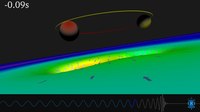
Photo from wikipedia
The nature of the merger remnant of binary neutron star (BNS) remains an open question. From the theoretical point of view, one possible outcome is a supra-massive neutron star (SMNS),… Click to show full abstract
The nature of the merger remnant of binary neutron star (BNS) remains an open question. From the theoretical point of view, one possible outcome is a supra-massive neutron star (SMNS), which is supported by rigid rotation and through its survival of hundreds of seconds before collapsing into a black hole (BH). If this is the case, the SMNS can emit continuous gravitational waves (GW) and electromagnetic (EM) radiation, particularly in the X-ray band. In this work, the ellipticity and initial frequency of SMNS are constrained with a Bayesian framework using simulated X-ray and GW signals, which could be detected by The Transient High Energy Sky and Early Universe Surveyor (THESEUS) and Einstein Telescope (ET), respectively. We found that only considering the X-ray emission can not completely constrain the initial frequency and ellipticity of the SMNS, but it can reduce the ranges of the parameters. Afterwards, we can use the posterior distribution of the X-ray parameter estimates as a prior for the GW parameter estimates. It was found that the 95% credible region of the joint X-ray–GW analysis was about 105 times smaller than that of the X-ray analysis alone.
Journal Title: Monthly Notices of the Royal Astronomical Society
Year Published: 2023
Link to full text (if available)
Share on Social Media: Sign Up to like & get
recommendations!